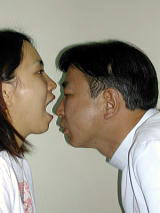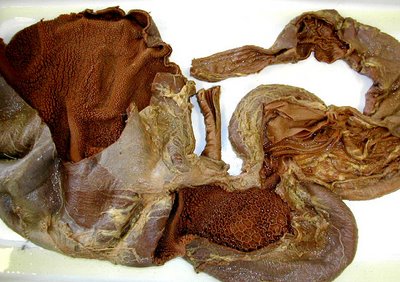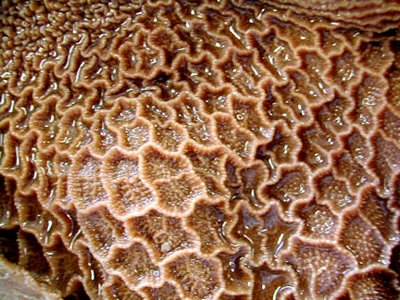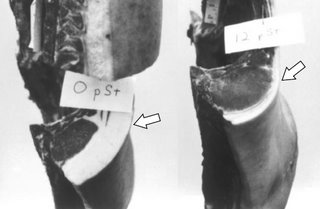
Tuesday, October 31, 2006
Carnivores Take Flight
Gather close your pet frogs and free-roaming canaries. It's the night for stalking by the ...

~~~~~~ Photo source: US Postal Service out-of-circulation 37-cent stamp. I propose a reissue.

Toast By Candlelight
Our electricity flicked off over the weekend. It was hours before power was restored.
The electricity seems to go out often here. If I was tasked to say something positive about that, and I'm scraping the blessings barrel here, if it happens in the winter we can take the food from the refrigerator and put it outside to keep it from perishing. If it happens in the summer we won't freeze at night!
One more thing ... it makes me appreciate electricity. You can't fathom the elation an electricity-addicted woman feels when suddenly, with no warning, every appliance that was humming or glowing when the current croaked jolts back to life. Joy, baby.
It's a little disconcerting when the electricity dies during meal prep. If I could anticipate an outage, I wouldn't fill the oven (electric) with a roast and some herbed red potatoes. Nope. Fortunately, we have a gas line to our hob, and the meal was salvaged by a cast iron Dutch oven pulling stovetop duty.
The FRE wanted his meager bread ration as toast that night. Not much pulls duty like an electric toaster.

The electricity seems to go out often here. If I was tasked to say something positive about that, and I'm scraping the blessings barrel here, if it happens in the winter we can take the food from the refrigerator and put it outside to keep it from perishing. If it happens in the summer we won't freeze at night!
One more thing ... it makes me appreciate electricity. You can't fathom the elation an electricity-addicted woman feels when suddenly, with no warning, every appliance that was humming or glowing when the current croaked jolts back to life. Joy, baby.
It's a little disconcerting when the electricity dies during meal prep. If I could anticipate an outage, I wouldn't fill the oven (electric) with a roast and some herbed red potatoes. Nope. Fortunately, we have a gas line to our hob, and the meal was salvaged by a cast iron Dutch oven pulling stovetop duty.
The FRE wanted his meager bread ration as toast that night. Not much pulls duty like an electric toaster.

Friday, October 27, 2006
Antacid Use Linked to Bad Breath
 It's bad enough that people with acid reflux (GERD) who take prescription antacids have to suffer pain and social isolation from their symptoms, as well as disrupted protein digestion, reduced vitamin and mineral absorption, and other risky and unwelcome side effects of their acid-reducing medication.
It's bad enough that people with acid reflux (GERD) who take prescription antacids have to suffer pain and social isolation from their symptoms, as well as disrupted protein digestion, reduced vitamin and mineral absorption, and other risky and unwelcome side effects of their acid-reducing medication.Now doctors in Brazil are reporting1 the proton pump inhibitors (PPIs: Prilosec, Prevacid, Nexium, Aciphex, Protonix) used to treat GERD may cause bad breath:
"Once we excluded oral causes of halitosis, we discovered that bacteria overgrowth associated with PPI usage might play a role in causing bad breath".
- Luciana Camacho-Lobato, MD, PhD, New Study Links Bad Breath to Heartburn, GERD
Cruel.
Wednesday, October 25, 2006
Acid Reflux, a.k.a. GERD*
* Gastroesophageal Reflux Disease
Constance asked:
First, some background.
 The number of people in the US known to experience symptoms of GERD at least once a month about equals the entire population of the UK. There's no inference there that British food causes heartburn. This number does not include the people who suffer in silence, which is an ordeal in itself given that belching often appears on a list of GERD's symptoms.
The number of people in the US known to experience symptoms of GERD at least once a month about equals the entire population of the UK. There's no inference there that British food causes heartburn. This number does not include the people who suffer in silence, which is an ordeal in itself given that belching often appears on a list of GERD's symptoms.
The goal for managing GERD is to keep stomach contents within the confines of the stomach, and/or to lessen the harmful effects of stomach contents that involuntarily enter the esophagus. There's a muscle that rings the place where the esophagus empties into the stomach. It's called a sphincter; because it's at the lower end of the esophagus it's known as the Lower Esophageal Sphincter or LES.2 A healthy LES squeezes closed after food passes into the stomach. If it gapes, stomach contents can splash back into the esophagus. That might not be too uncomfortable or worrisome, but for the tenacious effort the body makes at keeping stomach contents acidic.
Now some suggestions. I'll categorize these into physical therapies and chemical therapies.
Physical Therapies - Making Gravity Work For You
I'll discuss chemical therapies in a later post.
~~~~~~ 1 Disclaimer: If the esophagus is in a chronic state of inflammation or has experienced damage, antacid therapy may be warranted. Left untreated, severe esophagitis can lead to a precancerous condition called Barrett's esophagus, although it's uncommon. Unfortunately, how you feel is not a reliable indicator of how damaged the cells of the esophagus may be. So if your doctor has determined that you're a candidate for prescription antacid therapy, it may be with good reason. Inviting perks from pharmaceutical companies for prescribing their drugs does not constitute good reason.
Thus, as with any medical condition, it's prudent to check with your physician before adopting advice you may read on a blog.
2 Illustation of LES by Christy Krames, MA CMI.
Constance asked:
"Any suggestions for getting rid of acid reflux that don't involve antacids?"Yes, a few come to mind.1
First, some background.
 The number of people in the US known to experience symptoms of GERD at least once a month about equals the entire population of the UK. There's no inference there that British food causes heartburn. This number does not include the people who suffer in silence, which is an ordeal in itself given that belching often appears on a list of GERD's symptoms.
The number of people in the US known to experience symptoms of GERD at least once a month about equals the entire population of the UK. There's no inference there that British food causes heartburn. This number does not include the people who suffer in silence, which is an ordeal in itself given that belching often appears on a list of GERD's symptoms.The goal for managing GERD is to keep stomach contents within the confines of the stomach, and/or to lessen the harmful effects of stomach contents that involuntarily enter the esophagus. There's a muscle that rings the place where the esophagus empties into the stomach. It's called a sphincter; because it's at the lower end of the esophagus it's known as the Lower Esophageal Sphincter or LES.2 A healthy LES squeezes closed after food passes into the stomach. If it gapes, stomach contents can splash back into the esophagus. That might not be too uncomfortable or worrisome, but for the tenacious effort the body makes at keeping stomach contents acidic.
Now some suggestions. I'll categorize these into physical therapies and chemical therapies.
Physical Therapies - Making Gravity Work For You
- Do not bend over or, if you're so moved, stand on your head, after eating. Any form of reclining falls into this category. If your sleeping position involves lying down, it's not a bad idea to make sure most of your meal has left your stomach before getting some shut-eye; 20 minutes is not long enough, 2 to 3 hours is much better. Elevating your head and upper back while sleeping is also helpful. Elevating just your head with a few pillows while leaving most of your torso in a horizontal position can cinch your esophageal pipe, impeding pressure-reducing burps.
 Yoga is recommended as a therapy for heartburn. For its ability to hasten gastric emptying, and temper stress, it's one fine tool in the arsenal. One caveat (forgive me if this is obvious): certain poses, such as downward facing dog (shown), should be avoided after a meal.
Yoga is recommended as a therapy for heartburn. For its ability to hasten gastric emptying, and temper stress, it's one fine tool in the arsenal. One caveat (forgive me if this is obvious): certain poses, such as downward facing dog (shown), should be avoided after a meal. - Do not shake contents. Jumping up and down shakes contents. There are other less deliberate forms of shaking. These include abrupt laughter (may you be so blessed), hic-cups (may you never be so cursed) (although if you are, digital rectal massage has been shown to terminate intractable hiccups), and spontaneous operatic singing. I'm not sure if rapping (Eminem, 50 cent) puts demands on the diaphragm enough to count. I'll go rap in front of the mirror and get back to you on that.
- Do not cinch the sac that contains the contents. Think of what would happen if you squeezed a partially-filled water balloon - and the nozzle had a leak. Tight belts cinch contents. So do elastic waists, tight jeans, girdles, spandex, long compressing hugs, and sucking it in when your amour du jour walks by.
Any condition that expands girth is tantamount to cinching the sac. It can increase gastric pressure and contribute to acid reflux. Pregnancy and obesity are two. Another is overeating, which leads to my last tip ... - Do not consume large meals. A big food dump increases upward pressure. If your eyes are bigger than your stomach, close them.
I'll discuss chemical therapies in a later post.
Thus, as with any medical condition, it's prudent to check with your physician before adopting advice you may read on a blog.
2 Illustation of LES by Christy Krames, MA CMI.
Thursday, October 19, 2006
Chips in the Microwave
Nandita posted a great recipe for "Almost Fat Free Sweet Potato Chips" on her blog, Saffron Trail. She found it on another blog, 28 Cooks.
Below is 28 Cooks' recipe for "Microtato Chips". I encourage you to click her link, if just for that beautiful chip pic she took to adorn her post1. Talk about stacked.
As easy as Nandita and Fiber from 28 Cooks made this sound, it took a little getting used to for me. But I was determined since fatty chips are the scourge of many a fanatic cook's friend.
The first few times using the microwave I was left with either a gummy mess or burnt crisps.
I decided to try the oven.
I drizzled a teaspoon of olive oil over thin slices of white potato and tossed. No, tossed isn't the right word. I slapped and rubbed 40-odd, cold, limp slices together until they were coated with oil. I then slapped and rubbed in about 1 teaspoon of kosher salt. A tad time-consuming but it did leave my fingers nicely moisturized. I laid the oiled slices on an aluminum foil-covered cookie sheet - a mistake I paid for. There were some minor overlaps - another mistake I paid for. I put them in a 300ºF oven (that low temp was probably another mistake), set the timer (to count up, not down), and waited - periodically trying to disengage one gluey slice from another and turn. I removed them after 1 hour, 34 minutes, and 17 seconds (01:34:17).
Behold my acrylamide feast.


The pictures don't do these chips justice. They were an utter failure in so many ways. First, 40 chips in 01:34:17 doesn't square, not with my time-management geometry. And you could etch your name in a mirror with a shard of one of these cooled, golden-brown, oven-baked crystals. The FRE ate the whole batch, god bless his merciful palate. But, I knew, it was ...
Back to the microwave.
My goal was a crispy, evenly browned chip. I'm thinking that doesn't place me in a minority. All 4 samples below were microwaved on a rotating carousel for 4 minutes on parchment paper sprayed with PAM®. They were sliced from the same Yukon gold potato, on a mandolin, to about 1/16 inch thick.

Upper Left - Microwave power: High 100%, 4 min. Light coating of olive oil.
Upper Right - Microwave power: High 100%, 4 min. No oil.
Lower Left - Microwave power: Medium 50%, 4 min. Light coating of olive oil.
Lower Right - Microwave power: Medium 50%, 4 min. No oil.
Here's what worked for me:
Less Time
The 5-7 minutes recommended cooking time was too long. I was wiping smoke from the walls of my microwave. Four minutes worked better. As noted by others, this may be a microwave quirk.
Less Power
High power cooked unevenly. Some chips contained both burnt areas and chewy, undercooked areas. Power may be another microwave quirk.
Less Oil
The presence of fat hastened cooking, but much like high power that faster cooking resulted in a marbled-looking, unevenly cooked chip. Believe it or not, the crispiest and most evenly-browned chips were entirely fat-free - although one trades off mouth feel. (The Lower Right chip was unusual in that it was the darkest of the fat-free bunch, but I chose it to show more evenness in cooking.)
I'm happy with my 4-minute, 50% power, as-little-oil-as-will-make-the-salt-stick chip. Your experience may be different given the variability of microwave ovens, but do try it. Thanks to Nandita and Fiber I now have new uses for starchy vegetables and a microwave oven. To the bean-counters at TERRA® Chips, your competition is afoot.
~~~~~~ 1 As much as I love Fiber's photo, I can't figure why her fat-free chips shine like a fish out of water but mine look as dry as day-old bread crust (but tasty). I'd love to know her technique!
Below is 28 Cooks' recipe for "Microtato Chips". I encourage you to click her link, if just for that beautiful chip pic she took to adorn her post1. Talk about stacked.
2 large potatoes, freshly scrubbed
cooking spray
parchment paper or wax paper
desired seasoning
a microwave
Thinly slice potatoes, using either a mandolin, or a regular vegetable peeler. Spray a sheet of parchment paper (or wax paper) lightly with cooking spray, and lay potatoes out in a single layer. Season with desired seasoning, and place in the microwave. Microwave on high, 5-7 minutes, until chips start to brown. Remove from the oven, and cool for a few seconds. Enjoy!
As easy as Nandita and Fiber from 28 Cooks made this sound, it took a little getting used to for me. But I was determined since fatty chips are the scourge of many a fanatic cook's friend.
The first few times using the microwave I was left with either a gummy mess or burnt crisps.
I decided to try the oven.
I drizzled a teaspoon of olive oil over thin slices of white potato and tossed. No, tossed isn't the right word. I slapped and rubbed 40-odd, cold, limp slices together until they were coated with oil. I then slapped and rubbed in about 1 teaspoon of kosher salt. A tad time-consuming but it did leave my fingers nicely moisturized. I laid the oiled slices on an aluminum foil-covered cookie sheet - a mistake I paid for. There were some minor overlaps - another mistake I paid for. I put them in a 300ºF oven (that low temp was probably another mistake), set the timer (to count up, not down), and waited - periodically trying to disengage one gluey slice from another and turn. I removed them after 1 hour, 34 minutes, and 17 seconds (01:34:17).
Behold my acrylamide feast.


The pictures don't do these chips justice. They were an utter failure in so many ways. First, 40 chips in 01:34:17 doesn't square, not with my time-management geometry. And you could etch your name in a mirror with a shard of one of these cooled, golden-brown, oven-baked crystals. The FRE ate the whole batch, god bless his merciful palate. But, I knew, it was ...
Back to the microwave.
My goal was a crispy, evenly browned chip. I'm thinking that doesn't place me in a minority. All 4 samples below were microwaved on a rotating carousel for 4 minutes on parchment paper sprayed with PAM®. They were sliced from the same Yukon gold potato, on a mandolin, to about 1/16 inch thick.

Upper Left - Microwave power: High 100%, 4 min. Light coating of olive oil.
Upper Right - Microwave power: High 100%, 4 min. No oil.
Lower Left - Microwave power: Medium 50%, 4 min. Light coating of olive oil.
Lower Right - Microwave power: Medium 50%, 4 min. No oil.
Here's what worked for me:
Less Time
The 5-7 minutes recommended cooking time was too long. I was wiping smoke from the walls of my microwave. Four minutes worked better. As noted by others, this may be a microwave quirk.
Less Power
High power cooked unevenly. Some chips contained both burnt areas and chewy, undercooked areas. Power may be another microwave quirk.
Less Oil
The presence of fat hastened cooking, but much like high power that faster cooking resulted in a marbled-looking, unevenly cooked chip. Believe it or not, the crispiest and most evenly-browned chips were entirely fat-free - although one trades off mouth feel. (The Lower Right chip was unusual in that it was the darkest of the fat-free bunch, but I chose it to show more evenness in cooking.)
I'm happy with my 4-minute, 50% power, as-little-oil-as-will-make-the-salt-stick chip. Your experience may be different given the variability of microwave ovens, but do try it. Thanks to Nandita and Fiber I now have new uses for starchy vegetables and a microwave oven. To the bean-counters at TERRA® Chips, your competition is afoot.
Monday, October 16, 2006
World Food Day 2006
How can I write a food blog and not promote the one day of the year set aside to honor food worldwide - and to respect what impact the lack of it can have.
Visit World Food Day 2006 in the US.

Visit World Food Day 2006 Globally (sponsored by the Food and Agricultural Association of the United Nations, FAO UN).

To commemorate the day, President Clinton issued a proclamation in 1993:

The text:
~~~~~~ If I didn't know better, I'd say that third paragraph was strongly influenced by President Clinton's then Vice President and author of the recent book/documentary, An Inconvenient Truth , Al Gore.
, Al Gore.
A clue:
I liked that Clinton "call[ed] on all Americans to observe these days with appropriate programs and activities." I haven't heard anything today from our current president. Please let me know if you do!
~~~~~~  Update, Oct 17: No word yet on a Bush statement. But, shiver me timbers, the Pope weighed in:
Update, Oct 17: No word yet on a Bush statement. But, shiver me timbers, the Pope weighed in:
Visit World Food Day 2006 in the US.

Visit World Food Day 2006 Globally (sponsored by the Food and Agricultural Association of the United Nations, FAO UN).

To commemorate the day, President Clinton issued a proclamation in 1993:

The text:
Arising from poverty, homelessness, civil strife or famine, hunger burdens the lives of nearly 800 million people throughout the world. Women and children suffer the most. Studies suggest that in developing countries, some 36 percent of children under 6 years of age are moderately or severely undernourished.
On this World Food Day, let us commit ourselves to bringing change to the lives of those who suffer from hunger and to preserving the resources we will need in the years ahead.
Failure to protect our environment now and in the future will clearly affect the ability of countries to produce food and fiber for growing populations. The United Nations has indicated that the world may not be able to feed itself by sometime early in the next century if we continue to abuse productive soil. If world food production is to be maintained and enhanced, we must learn to safeguard the biological diversity that underpins our agricultural system. Today, the biological foundation is imperiled. Traditional crop varieties and animal breeds are becoming endangered. Many are already extinct. When we lose a traditional wheat or rice variety, we lose its unique characteristics and its potential pest and disease resistance, drought tolerance, or nutritional benefits. Nature's diversity is a precious inheritance. We cannot live on this earth without it. Through sound agricultural practices and intelligent shepherding of our natural resources, we can nourish and protect our land, forests, rivers, and streams.
The almost constant threat of famine in Africa and the continuing food problems in Asia should remind us all of our global vulnerability, especially as the population continues to grow. Raising the global community's awareness of the hunger that afflicts the young, the infirm, the poor, and the elderly -- and considering the needs of others each day -- can bring change and help ensure our food supply for the future.
The Congress, by House Joint Resolution 218, has designated October 16, 1993, and October 16, 1994, as "World Food Day" and has authorized and requested the President to issue a proclamation in observance of these days.
NOW, THEREFORE, I, WILLIAM J. CLINTON, President of the United States of America, do hereby proclaim October 16, 1993, and October 16, 1994, as World Food Day. I call on all Americans to observe these days with appropriate programs and activities.
IN WITNESS WHEREOF, I have hereunto set my hand this sixteenth day of October, in the year of our Lord nineteen hundred and ninety-three, and of the Independence of the United States of America the two hundred and eighteenth.
A clue:
"... genetic erosion and the loss of biological diversity is the greatest single strategic threat facing mankind."The FAO has a superb animated map of hunger in the world from 1970 to 2003. (Wow, is North Korea red. I wonder how the new sanctions against them will affect the population's already severely undernourished situation. Can it get any redder?)
- Earth in the Balance, 1993, Al Gore
I liked that Clinton "call[ed] on all Americans to observe these days with appropriate programs and activities." I haven't heard anything today from our current president. Please let me know if you do!
 Update, Oct 17: No word yet on a Bush statement. But, shiver me timbers, the Pope weighed in:
Update, Oct 17: No word yet on a Bush statement. But, shiver me timbers, the Pope weighed in:"... local communities also need to be involved in choices and decisions concerning land use, since farmland is being diverted increasingly to other purposes, often with damaging effects on the environment.”Funny, I don't see Pope Benedict XVI and Al Gore sharing the same holy bench, but they sure share the same providence.
- Pope Benedict XVI, in a message to the FAO, Re: World Food Day 2006's theme, Investment in Agriculture.
Tuesday, October 10, 2006
The Season for Walnuts
 It's October. Walnuts are in season. And by the looks of this study1, the season for walnuts should be during every meal, at least meals that are high in saturated fat. Squirrel them away!
It's October. Walnuts are in season. And by the looks of this study1, the season for walnuts should be during every meal, at least meals that are high in saturated fat. Squirrel them away!Researchers in Spain fed a high-saturated-fat meal to two groups2. One group received 25g olive oil (5 teaspoons) as part of the meal. The other group received 40g walnuts (8 shelled).
Folks who ate walnuts had better elasticity in their arteries after the meal than folks who ate olive oil.3 Elasticity is good. Dilation is good. Stretch, baby, stretch.
After you eat a meal high in saturated fat, the elasticity of your arteries typically declines. It recovers after about 6 hours, as long as your blood vessels don't have to contend with another high-fat assault. Non-stop high-saturated-fat assaults can lay the groundwork for some pretty rigid vessels.
I'm a big fan of consuming olive oil. So I'm going to emphasize another finding of this study. The addition of either olive oil or walnuts to the meal helped fend off oxidation of LDL cholesterol and cut short production of inflammatory compounds - both of which are stimulated by the likes of salami and cheese sandwiches. Inflammation and oxidation are thought to contribute to plaque formation (a topic Dr. Davis writes so thoroughly and effortlessly about on his blog). So don't let this study, financed in part by the California Walnut Commission, retard your use of a good extra-virgin olive oil.
2 The meals consisted of salami and cheese and contained 80 grams of fat. That's a good 720 calories contributed by fat alone. High-fat? I'll say.
3 This study actually used a desirable crossover design, meaning it was performed at least twice using the same people. Intervention and control groups are switched in the second round. The groups here consisted of people with normal cholesterol and people with high. Benefits were found regardless of cholesterol level.
Photo credit goes to Unexplained Bacon.
Sunday, October 08, 2006
Cows' Stomachs Harbor E. coli O157:H7 ... But They Didn't Used To
Quick, if seeing innards makes yours convulse, avert your eyes.
Some Background
Below is a cow's stomach.1 A cow is a ruminant, meaning it eats the same food more than once. The first feast is chewed, swallowed and then regurgitated for a cordial second chew. Regurgitated mass is known as cud, and cows chew theirs, or ruminate, with aplomb.
All this regurgitating and reswallowing is necessary to reduce cellulose fibers (and other carbohydrates and proteins) to a size that resident bacteria, protozoa, and fungi can munch on. It's facilitated by a uniquely designed stomach, one consisting of 4 chambers: a rumen, reticulum, omasum, and abomasum.

The chambers are recognizable in the photograph from left to right. The first 3 chambers, which together comprise more than 3/4s of this digestive compartment, are more precisely defined as a forestomach; they act as a massive fermentation vat. The last chamber, the little abomasum (barely visible off to the right), is the cow's true stomach and by itself bears resemblance to a human stomach.
You gotta love the specialization and complexity of a ruminant's gut, at least I do. Reverse peristalsis? What a deal. There have been some mighty fine meals in my past for which I would have welcomed a little reverse peristalsis and rumination.

Photo above shows a close-up of the 2nd chamber, the reticulum.
It's from this chamber that undigested matter is compressed and pushed back up the esophagus.
Acid Reflux
Ruminants evolved to consume grasses and other plant matter structured largely of cellulose. These fibers are digested by billions of microbes in the forestomach (up to 50 billion bacteria in 1 milliliter of rumen fluid!), an activity that's performed best at a pH of 6 to 7. Cows secrete a lot of saliva, over 100 liters a day, in part to maintain that all-important rumen pH.
The pH decreases (becomes more acidic) when cows are fed grain in lieu of grass. This isn't a good thing for the cow. In fact, according to the Merck Veterinary Manual, "Grain overload is an acute disease of ruminants that is characterized by indigestion, rumen stasis, dehydration, acidosis, toxemia, incoordination, collapse, and frequently death."
When the pH drops to around 5.5, protozoa begin to die off, and the bacteria population undergoes marked change.
Here's where pieces of the recent E. coli-contaminated spinach puzzle begin to fit.
The Dirty Greek clued me in with his post "Why Is The Spinach Contaminated?" where he cites a NTYs article written by Nina Planck, author of Real Food: What to Eat and Why.
He found her same passages of interest:
[Recall the billions of bacteria per milliliter of stomach fluid. Many die off, but imagine the potential infection pool of just one grain-engorged cow.]
The Solution
She predicts future outbreaks.
Only yesterday, an Iowa company recalled 5,200 pounds of ground beef, suspected of being contaminated with E. coli O157:H7.
~~~~~~ 1 These photos of mammalian digestive organs were taken by students and faculty at the University of Washington. More can be found here.
To me they're works of art, both the pictures and the anatomy.
Some Background
Below is a cow's stomach.1 A cow is a ruminant, meaning it eats the same food more than once. The first feast is chewed, swallowed and then regurgitated for a cordial second chew. Regurgitated mass is known as cud, and cows chew theirs, or ruminate, with aplomb.
All this regurgitating and reswallowing is necessary to reduce cellulose fibers (and other carbohydrates and proteins) to a size that resident bacteria, protozoa, and fungi can munch on. It's facilitated by a uniquely designed stomach, one consisting of 4 chambers: a rumen, reticulum, omasum, and abomasum.

The chambers are recognizable in the photograph from left to right. The first 3 chambers, which together comprise more than 3/4s of this digestive compartment, are more precisely defined as a forestomach; they act as a massive fermentation vat. The last chamber, the little abomasum (barely visible off to the right), is the cow's true stomach and by itself bears resemblance to a human stomach.
You gotta love the specialization and complexity of a ruminant's gut, at least I do. Reverse peristalsis? What a deal. There have been some mighty fine meals in my past for which I would have welcomed a little reverse peristalsis and rumination.

Photo above shows a close-up of the 2nd chamber, the reticulum.
It's from this chamber that undigested matter is compressed and pushed back up the esophagus.
Acid Reflux
Ruminants evolved to consume grasses and other plant matter structured largely of cellulose. These fibers are digested by billions of microbes in the forestomach (up to 50 billion bacteria in 1 milliliter of rumen fluid!), an activity that's performed best at a pH of 6 to 7. Cows secrete a lot of saliva, over 100 liters a day, in part to maintain that all-important rumen pH.
The pH decreases (becomes more acidic) when cows are fed grain in lieu of grass. This isn't a good thing for the cow. In fact, according to the Merck Veterinary Manual, "Grain overload is an acute disease of ruminants that is characterized by indigestion, rumen stasis, dehydration, acidosis, toxemia, incoordination, collapse, and frequently death."
When the pH drops to around 5.5, protozoa begin to die off, and the bacteria population undergoes marked change.
Here's where pieces of the recent E. coli-contaminated spinach puzzle begin to fit.
The Dirty Greek clued me in with his post "Why Is The Spinach Contaminated?" where he cites a NTYs article written by Nina Planck, author of Real Food: What to Eat and Why.
He found her same passages of interest:
"E. coli is abundant in the digestive systems of healthy cattle and humans, and if your potato salad happened to be carrying the average E. coli, the acid in your gut is usually enough to kill it.
But the villain in this outbreak, E. coli O157:H7, is far scarier, at least for humans. Your stomach juices are not strong enough to kill this acid-loving bacterium, which is why it’s more likely than other members of the E. coli family to produce abdominal cramps, diarrhea, fever and, in rare cases, fatal kidney failure.
Where does this particularly virulent strain come from? It’s not found in the intestinal tracts of cattle raised on their natural diet of grass, hay and other fibrous forage. No, O157 thrives in a new — that is, recent in the history of animal diets — biological niche: the unnaturally acidic stomachs of beef and dairy cattle fed on grain, the typical ration on most industrial farms. It’s the infected manure from these grain-fed cattle that contaminates the groundwater and spreads the bacteria to produce, like spinach, growing on neighboring farms."
[Recall the billions of bacteria per milliliter of stomach fluid. Many die off, but imagine the potential infection pool of just one grain-engorged cow.]
The Solution
"In 2003, The Journal of Dairy Science noted that up to 80 percent of dairy cattle carry O157. [However] when cows were switched from a grain diet to hay for only five days, O157 declined 1,000-fold."
She predicts future outbreaks.
"California’s spinach industry is now the financial victim of an outbreak it probably did not cause, and meanwhile, thousands of acres of other produce are still downstream from these lakes of E. coli-ridden cattle manure."
Only yesterday, an Iowa company recalled 5,200 pounds of ground beef, suspected of being contaminated with E. coli O157:H7.
To me they're works of art, both the pictures and the anatomy.
Wednesday, October 04, 2006
Growth Hormone and Your Pork Chop
Where's the juice?
Americans want a reduced-fat pork chop. Maybe Americans don't really want a reduced-fat pork chop, given their memories of fry-dried pork chops as a child. But public health experts want Americans to want a reduced-fat pork chop. So experts in animal husbandry gave pigs growth hormone.1 Boy, does growth hormone (GH)2 cut the fat.
 A study that compared pigs3, some with lots of GH and others with normal amounts, found those slaughtered after reaching 92 kg (203 lbs) had:
A study that compared pigs3, some with lots of GH and others with normal amounts, found those slaughtered after reaching 92 kg (203 lbs) had:
85% less total carcass fat
85% less saturated fat
91% less monounsaturated fat
66% less polyunsaturated fat
... than controls. Can you imagine?
The authors of this study concluded:
 The pigs in the study above were transgenic, meaning their DNA had been altered to contain a gene from a cow, a gene that manufactures GH (bovine GH or bGH). That's a handy way of upping GH. Another way is to manufacture the GH outside of the pig, usually in a bacterium (called recombinant porcine GH or rpGH), and then inject it back into the pig ... often.
The pigs in the study above were transgenic, meaning their DNA had been altered to contain a gene from a cow, a gene that manufactures GH (bovine GH or bGH). That's a handy way of upping GH. Another way is to manufacture the GH outside of the pig, usually in a bacterium (called recombinant porcine GH or rpGH), and then inject it back into the pig ... often.
(Photo shows effect of injected GH (pST) on right subject, left subject received no GH ... That's a lotta fatback.)
This was just one study among many. I don't believe GH is currently approved for use in pigs, either exogenous (injected or patched) or endogenous (genetic modification), because of problems with fertility, arthritis, heart and kidney disease, and impaired immune responses. It's under review though. (In 1993, the FDA approved GH for use in cows to increase milk production.)
If It Does That To Pigs, Can It Do That To Us?
Yes.
Not only does growth hormone reduce fat stores, but it stimulates muscle and bone growth. Those are the most pronounced effects. Human growth hormone (hGH) is prescribed for people with GH deficiencies.
It's also become fairly attractive to people who for some reason would like to see a little less fat and a little more muscle definition in their physiques. I imagine that relatively healthy people seeking those attributes might evolve to look something like Madonna. That's not an indictment, but one wonders how a 48-year-old mother of 2 who has been known to enjoy her cigarettes and fermented barley brews manages to strike such a pose. (Click for larger.)




~~~~~~ 1 I don't endorse the use of hormones in livestock or peoplestock. I just like to talk about it.
2 Growth hormone is also known as somatotropin (ST).
3 Photograph is the best representation of the study I could find. It's not directly related to these researchers' work.
Americans want a reduced-fat pork chop. Maybe Americans don't really want a reduced-fat pork chop, given their memories of fry-dried pork chops as a child. But public health experts want Americans to want a reduced-fat pork chop. So experts in animal husbandry gave pigs growth hormone.1 Boy, does growth hormone (GH)2 cut the fat.
 A study that compared pigs3, some with lots of GH and others with normal amounts, found those slaughtered after reaching 92 kg (203 lbs) had:
A study that compared pigs3, some with lots of GH and others with normal amounts, found those slaughtered after reaching 92 kg (203 lbs) had:85% less total carcass fat
85% less saturated fat
91% less monounsaturated fat
66% less polyunsaturated fat
... than controls. Can you imagine?
The authors of this study concluded:
"If levels of growth hormone secretion could be precisely regulated during the rapid growth phase of market hogs, it might be possible to provide consumers with an ultra-low-fat pork product."
- Lipid Composition of Carcass Tissue from Transgenic Pigs Expressing a Bovine Growth Hormone Gene
 The pigs in the study above were transgenic, meaning their DNA had been altered to contain a gene from a cow, a gene that manufactures GH (bovine GH or bGH). That's a handy way of upping GH. Another way is to manufacture the GH outside of the pig, usually in a bacterium (called recombinant porcine GH or rpGH), and then inject it back into the pig ... often.
The pigs in the study above were transgenic, meaning their DNA had been altered to contain a gene from a cow, a gene that manufactures GH (bovine GH or bGH). That's a handy way of upping GH. Another way is to manufacture the GH outside of the pig, usually in a bacterium (called recombinant porcine GH or rpGH), and then inject it back into the pig ... often.(Photo shows effect of injected GH (pST) on right subject, left subject received no GH ... That's a lotta fatback.)
This was just one study among many. I don't believe GH is currently approved for use in pigs, either exogenous (injected or patched) or endogenous (genetic modification), because of problems with fertility, arthritis, heart and kidney disease, and impaired immune responses. It's under review though. (In 1993, the FDA approved GH for use in cows to increase milk production.)
If It Does That To Pigs, Can It Do That To Us?
Yes.
Not only does growth hormone reduce fat stores, but it stimulates muscle and bone growth. Those are the most pronounced effects. Human growth hormone (hGH) is prescribed for people with GH deficiencies.
It's also become fairly attractive to people who for some reason would like to see a little less fat and a little more muscle definition in their physiques. I imagine that relatively healthy people seeking those attributes might evolve to look something like Madonna. That's not an indictment, but one wonders how a 48-year-old mother of 2 who has been known to enjoy her cigarettes and fermented barley brews manages to strike such a pose. (Click for larger.)




2 Growth hormone is also known as somatotropin (ST).
3 Photograph is the best representation of the study I could find. It's not directly related to these researchers' work.
Subscribe to:
Comments (Atom)
